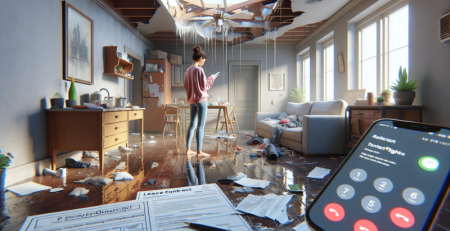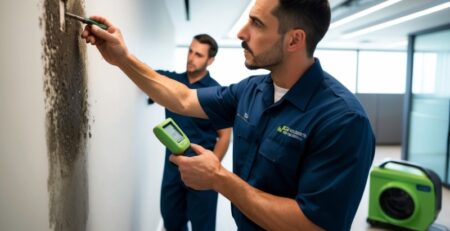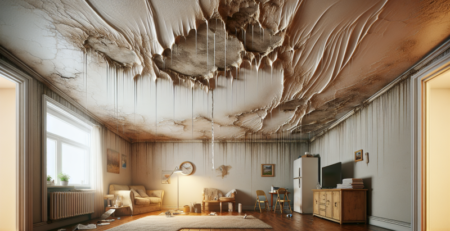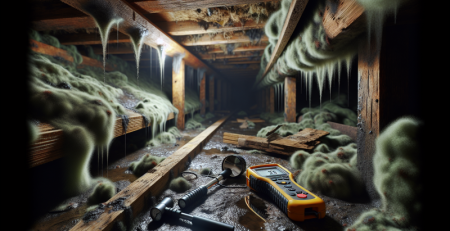Fire Damage: How to Clean HVAC Systems Safely
When a fire strikes your home or business, the visible damage is only part of the problem—hidden dangers often linger in your HVAC system. Smoke, soot, and toxic residues can infiltrate your heating and cooling systems, spreading contaminants throughout your property long after the flames are extinguished. Proper HVAC cleaning after fire damage is essential to restore indoor air quality and ensure the safety of your environment. At Kraus Restoration, NJ’s leaders in water, mold, and fire damage restoration, we understand the urgency of addressing fire-related HVAC contamination. Our IICRC-certified experts provide 24/7 emergency services with a rapid response across Central and Northern New Jersey. Whether you’re dealing with smoke damage, soot buildup, or lingering odors, our team is equipped to safely and thoroughly clean your HVAC system, helping you breathe easier and recover faster. Call us today at (973) 886-2021 for expert fire damage restoration services tailored to your needs.
Understanding the Impact of Fire Damage on HVAC Systems
When a fire occurs, the visible destruction often overshadows the hidden damage that can compromise the safety and functionality of a building. One of the most overlooked yet critical components affected by fire is the HVAC (Heating, Ventilation, and Air Conditioning) system. These systems are essential for maintaining indoor air quality and temperature control, but after a fire, they can become conduits for hazardous contaminants, smoke particles, and soot. Understanding how fire damage impacts HVAC systems is crucial for ensuring a safe and effective cleanup process.
Fire can affect HVAC systems in several ways. First, the intense heat can warp or melt ductwork, damage electrical components, and compromise insulation. Even if the fire did not directly reach the HVAC system, smoke and soot can infiltrate the ducts and mechanical parts. These residues are not only corrosive but also pose serious health risks if circulated throughout the building. According to the National Fire Protection Association (NFPA), smoke inhalation is a leading cause of fire-related deaths, highlighting the importance of addressing air quality after a fire.
Moreover, soot and smoke particles are microscopic and can easily settle within the HVAC system. Once inside, they can be recirculated every time the system operates, spreading contaminants throughout the property. This can lead to persistent odors, respiratory issues, and even long-term damage to the HVAC components. The Environmental Protection Agency (EPA) warns that exposure to fine particulate matter from smoke can aggravate asthma, bronchitis, and other respiratory conditions.
“Even a small fire can leave behind dangerous residues in your HVAC system that compromise indoor air quality and pose health risks to occupants.”
In addition to health concerns, fire damage can significantly reduce the efficiency and lifespan of HVAC systems. Soot buildup can clog filters, coat coils, and obstruct airflow, forcing the system to work harder and consume more energy. This not only increases utility bills but also accelerates wear and tear, potentially leading to costly repairs or premature replacement.
To illustrate the extent of potential damage, consider the following scenarios:
- A residential fire in the kitchen fills the home with smoke. The HVAC system, running at the time, draws in the smoke and distributes it throughout the house, contaminating every room.
- In a commercial building, a fire in one section causes soot to settle in the ductwork. Weeks later, employees begin to report respiratory issues due to the lingering contaminants being circulated by the HVAC system.
- After a warehouse fire, the HVAC system is found to have melted wiring and soot-covered components, rendering it inoperable and requiring a full system replacement.
These examples underscore the importance of a thorough inspection and cleaning of HVAC systems following any fire incident. Professional fire damage restoration services, such as those offered by Kraus Restoration, are essential for identifying hidden damage and ensuring that all contaminants are properly removed.
It is also important to note that fire damage often coincides with other issues such as water damage from firefighting efforts. This combination can create the perfect environment for mold growth within the HVAC system. In such cases, specialized services like mold cleanup may also be necessary to fully restore indoor air quality and system functionality.
For property owners and managers, understanding the full scope of fire damage is the first step toward recovery. Partnering with experienced professionals who offer comprehensive restoration services ensures that no aspect of the damage is overlooked. Whether you are dealing with a minor incident or a major fire, addressing the HVAC system is a critical component of the cleanup process.
For more information about how Kraus Restoration can help with fire and HVAC system cleanup, visit their about page or reach out through their contact form. Ensuring your HVAC system is clean and safe after a fire not only protects your property but also the health and well-being of everyone inside.
Assessing the Extent of Contamination and Damage
Before initiating any cleaning or restoration process after a fire, it is crucial to thoroughly evaluate the extent of contamination and damage within the HVAC system. Fire incidents can introduce a wide range of harmful substances into the air ducts, including soot, smoke particles, and even toxic residues from burned materials. These contaminants can compromise indoor air quality and pose serious health risks if not properly addressed. A comprehensive assessment helps determine the severity of the damage and guides the development of an effective cleaning strategy tailored to the specific conditions of the system.
The first step in the assessment process involves a visual inspection of all accessible components of the HVAC system. This includes air ducts, filters, coils, fans, and vents. Technicians look for visible signs of soot accumulation, discoloration, and residue buildup. In many cases, smoke can travel far beyond the immediate area of the fire, affecting parts of the HVAC system that may not show obvious signs of damage. Therefore, specialized tools such as borescopes and video inspection equipment are often used to examine hard-to-reach areas within the ductwork.
In addition to visual inspections, air quality testing is often conducted to identify the presence of airborne contaminants. This may include measuring levels of particulate matter, volatile organic compounds (VOCs), and other hazardous substances that may have been introduced during the fire. These tests provide valuable data that help determine whether the HVAC system is contributing to ongoing air quality issues within the building. If contaminants are detected, it confirms the need for a thorough cleaning and possibly even component replacement.
Another important aspect of the assessment is evaluating the structural integrity of the HVAC system. High temperatures from a fire can warp or melt plastic components, damage insulation, and weaken metal parts. Damaged components not only reduce the efficiency of the system but can also become sources of recurring contamination if not properly repaired or replaced. Technicians must carefully inspect each part of the system to ensure it is safe to operate and capable of functioning effectively after cleaning.
The type of fire and materials burned also influence the level of contamination. For example, fires involving synthetic materials can produce more toxic residues compared to those involving natural materials. Understanding the nature of the fire helps professionals anticipate the types of contaminants present and select the most appropriate cleaning methods. In some cases, specialized cleaning agents or equipment may be required to safely remove hazardous residues without damaging the HVAC components.
Documentation is a key part of the assessment process. Detailed records of the damage, contamination levels, and recommended actions are essential for insurance claims and future reference. These records also help ensure that all areas of concern are addressed during the cleaning process, reducing the risk of overlooking hidden contamination.
Professional restoration companies, such as Kraus Restoration, offer expert assessment and cleaning services tailored to fire-damaged HVAC systems. Their team of trained technicians uses industry-standard protocols to evaluate and restore HVAC systems safely and effectively. To learn more about their comprehensive offerings, visit their services page. Whether the damage occurred in a residential or commercial setting, Kraus Restoration has the experience and resources to handle projects of all sizes, as demonstrated in their commercial design portfolio.
In conclusion, assessing the extent of contamination and damage in an HVAC system after a fire is a critical step that should never be overlooked. It ensures that all potential hazards are identified and addressed, paving the way for a safe and effective cleaning process. By relying on professional expertise and thorough evaluation methods, property owners can restore their HVAC systems to optimal condition and protect the health and safety of building occupants.
Safety Precautions Before Starting the Cleaning Process
Before beginning the process of cleaning HVAC systems after fire damage, it is crucial to take proper safety precautions to protect both the individuals performing the work and the integrity of the system itself. Fire-damaged environments can pose serious health and safety risks, including exposure to soot, smoke residues, toxic fumes, and structural instability. Ensuring that the area is safe to enter and that all necessary protective measures are in place is the first step toward a successful and safe cleanup.
Start by conducting a thorough assessment of the affected area. This should be done by a qualified professional who can identify potential hazards such as weakened structures, electrical issues, or lingering hot spots. Before any cleaning begins, ensure that the HVAC system is completely powered down to prevent electrical accidents. It is also essential to shut off the gas supply if the fire has affected any gas lines or appliances connected to the HVAC system.
Personal protective equipment (PPE) is a non-negotiable requirement when working in fire-damaged areas. This includes wearing gloves, safety goggles, N95 respirators or higher-grade masks, and protective clothing to prevent skin contact with hazardous residues. Fire residues can contain harmful chemicals and fine particulate matter that pose respiratory risks, so proper ventilation should be established in the workspace. If the HVAC system is still operational, it should remain off until it has been fully inspected and cleaned to avoid circulating contaminants throughout the property.
Another important step is to isolate the HVAC system from the rest of the building. This can be done by sealing off vents and ducts to prevent the spread of soot and debris during the cleaning process. Using plastic sheeting and duct tape can help contain the affected areas and minimize cross-contamination. Additionally, all filters should be removed and replaced, as they are likely to be saturated with soot and may impede airflow or reintroduce contaminants into the system.
It is also advisable to consult with fire restoration experts who have experience in HVAC system cleaning. These professionals can provide guidance on the best cleaning methods and tools to use, ensuring that the process is both effective and safe. For more information about the range of professional services available, you can visit our services page. Specialized equipment such as HEPA vacuums, negative air machines, and chemical cleaning agents may be necessary to thoroughly remove soot and smoke residues from ducts, coils, and other components.
In some cases, fire damage may have also led to water damage due to firefighting efforts. If this is the case, it is important to address any moisture issues promptly to prevent mold growth. You can learn more about how we handle such situations by exploring our water cleanup services. Moisture meters and thermal imaging cameras can be used to detect hidden dampness within the HVAC system or surrounding structures.
Finally, clear communication with all parties involved in the restoration process is essential. Whether you are a homeowner, property manager, or contractor, keeping everyone informed about the safety protocols and progress of the cleaning process helps ensure a coordinated and efficient effort. If you have specific questions or need personalized assistance, feel free to reach out through our contact page.
Taking these safety precautions seriously not only protects your health but also ensures that the HVAC system is restored to a safe and functional condition. Proper preparation and adherence to safety guidelines are key to a successful fire damage cleanup process.
Tools and Equipment Needed for Effective HVAC Cleaning
Cleaning HVAC systems after fire damage requires specialized tools and equipment to ensure a thorough and safe restoration process. Fire residues, including soot, ash, and smoke particles, can infiltrate ductwork and HVAC components, compromising air quality and system performance. To effectively clean and restore these systems, professionals rely on a combination of high-efficiency tools and industry-approved equipment designed specifically for post-fire environments.
One of the most essential tools used in HVAC cleaning after fire damage is a high-powered HEPA vacuum. These vacuums are equipped with filters capable of capturing microscopic particles, including soot and fine ash, without releasing them back into the air. HEPA vacuums are particularly effective for cleaning air ducts, vents, and other hard-to-reach areas within the HVAC system. In addition to vacuums, rotary brushes and air whips are commonly used to dislodge stubborn debris from duct walls. These mechanical tools help loosen contaminants that may have adhered to surfaces due to the sticky nature of smoke residues.
Negative air machines are another critical piece of equipment in the fire damage cleanup process. These machines create negative pressure within the HVAC system, preventing cross-contamination by ensuring that airborne particles are drawn into the machine’s filtration system rather than escaping into clean areas. When used in conjunction with containment barriers, negative air machines help maintain a controlled environment during the cleaning process.
Chemical cleaning agents and deodorizers also play a vital role in restoring HVAC systems after fire exposure. Specialized detergents are used to break down and remove oily soot deposits, while odor-neutralizing agents help eliminate lingering smoke smells. It is important to use only non-corrosive, HVAC-safe chemicals to avoid damaging sensitive components such as coils and electrical parts. In some cases, thermal fogging or ozone treatments may be employed to neutralize persistent odors within the ductwork.
Inspection tools such as borescopes and video inspection cameras are invaluable for assessing the extent of contamination within the HVAC system. These devices allow technicians to visually inspect the interior of ducts and other hidden components without dismantling the entire system. Accurate assessments help determine the appropriate cleaning methods and ensure that no areas are overlooked during the restoration process.
Personal protective equipment (PPE) is also essential for the safety of technicians performing HVAC cleaning after a fire. This includes respirators, gloves, protective suits, and eye protection to guard against exposure to hazardous particles and chemical agents. Ensuring the safety of the cleanup crew is just as important as restoring the HVAC system itself.
For property owners dealing with fire damage, it is crucial to hire experienced professionals who are equipped with the right tools and knowledge. At Kraus Restoration, our team uses advanced equipment and proven techniques to restore HVAC systems safely and efficiently. Learn more about our comprehensive fire cleanup services and how we can help protect your indoor air quality after a fire.
In addition to fire restoration, we also offer a range of other services, including mold cleanup and water damage restoration, ensuring your property is fully protected from all types of environmental hazards. Our commitment to quality and safety is reflected in every project we undertake. To see examples of our work, explore our residential design and commercial restoration projects.
Choosing the right tools and equipment is fundamental to the success of any HVAC cleaning operation following fire damage. With the proper approach and professional expertise, it is possible to restore your HVAC system to a clean, safe, and fully functional condition, ensuring the health and comfort of your indoor environment.
Step-by-Step Guide to Cleaning Fire-Damaged HVAC Components
Cleaning HVAC systems after fire damage requires a meticulous and methodical approach to ensure safety, restore air quality, and prevent further contamination. The process begins with a thorough inspection of the entire HVAC system, including ductwork, air handlers, filters, and vents. This initial assessment helps identify the extent of the damage and determine which components need cleaning, repair, or replacement. It is crucial to shut off the HVAC system before starting any cleaning to avoid circulating soot, smoke particles, or other contaminants throughout the property.
Once the system is powered down, the next step involves removing and discarding all filters, as they are likely saturated with smoke residue and debris. Replacing them with new, high-efficiency filters is essential to maintain indoor air quality. After filter removal, technicians use specialized vacuums equipped with HEPA filters to clean the interior surfaces of the ductwork and other accessible components. These vacuums are designed to capture fine particles without releasing them back into the air, ensuring a safer environment during the cleaning process.
Following vacuuming, the interior surfaces of the HVAC system are cleaned using approved chemical agents that are effective in removing soot and neutralizing odors. It is important to use non-corrosive, HVAC-safe cleaning solutions to avoid damaging sensitive components. In some cases, mechanical agitation tools may be used to dislodge stubborn soot deposits from duct walls and other surfaces. After cleaning, all components should be thoroughly dried to prevent mold growth, which can be a secondary issue after fire damage.
Deodorization is another critical step in the cleaning process. Smoke odors can linger in HVAC systems long after the visible soot is removed. Technicians often use thermal fogging or ozone treatments to neutralize these odors. These methods penetrate deep into the ductwork and other hidden areas, effectively eliminating smoke smells. However, these treatments should only be performed by trained professionals, as improper use can pose health risks.
Once cleaning and deodorization are complete, the system should be tested to ensure it is functioning properly. This includes checking airflow, thermostat operation, and overall system performance. If any components were damaged beyond repair, such as motors or electrical parts, they should be replaced before the system is put back into service. It is also advisable to conduct a final air quality test to confirm that the environment is safe for occupancy.
Hiring a professional restoration company with experience in fire-damaged HVAC systems is highly recommended. These experts have the tools, knowledge, and certifications necessary to perform the job safely and effectively. For more information about the services offered, visit the fire cleanup page. Additionally, understanding the company’s background and expertise can help you make an informed decision; you can learn more by visiting the about page.
In some cases, fire damage may also lead to water damage from firefighting efforts or mold growth due to lingering moisture. A comprehensive restoration plan should address these issues as well. If needed, Kraus Restoration also offers specialized water cleanup and mold cleanup services to ensure a complete recovery.
Properly cleaning fire-damaged HVAC systems is not just about restoring functionality but also about protecting the health and safety of building occupants. Smoke and soot contain harmful chemicals that can pose serious health risks if not thoroughly removed. By following a detailed, step-by-step cleaning process and working with experienced professionals, you can ensure that your HVAC system is restored safely and efficiently.
When to Call a Professional HVAC Restoration Service
While minor fire damage to your HVAC system may seem manageable, there are specific situations where calling a professional HVAC restoration service is not only recommended but essential for safety and efficiency. If the fire has caused extensive smoke infiltration, soot buildup, or structural damage to the ductwork, it is crucial to seek expert help. Smoke and soot particles can penetrate deep into the HVAC system, affecting indoor air quality and potentially causing long-term health issues if not properly removed. A professional team has the tools and expertise to conduct a thorough inspection, identify hidden damage, and implement a comprehensive cleaning and restoration plan.
Another key indicator that professional help is needed is the presence of lingering odors even after initial cleaning efforts. Persistent smoke smells often signal that contaminants remain trapped within the system. In such cases, professionals use specialized equipment like high-efficiency particulate air (HEPA) vacuums and thermal foggers to neutralize odors and sanitize the system. Additionally, if your HVAC system was operating during the fire, it likely circulated smoke and soot throughout the entire duct network, making a DIY cleanup insufficient. Professionals can ensure that all components, including coils, blowers, and air handlers, are properly cleaned and restored.
If you are unsure about the extent of the damage or how to proceed, reaching out to a trusted restoration company can provide clarity and peace of mind. Companies like Kraus Restoration offer a full range of services tailored to fire damage recovery, including HVAC system cleaning. Their trained technicians follow industry standards and use advanced techniques to restore your system safely and effectively. Moreover, if your property has experienced additional issues such as water damage from firefighting efforts or mold growth due to moisture, Kraus Restoration also provides specialized water cleanup and mold cleanup services to address these concerns comprehensively.
In commercial or residential settings where HVAC systems are more complex, professional intervention becomes even more critical. Large-scale systems require detailed assessments and customized solutions to ensure all components are functioning correctly post-fire. Kraus Restoration has extensive experience in both residential and commercial restoration projects, making them a reliable choice for comprehensive fire damage recovery. Their team can also assist with insurance documentation and provide detailed reports to support your claims process.
Ultimately, the decision to call a professional should be based on the severity of the fire, the complexity of your HVAC system, and your ability to safely and effectively perform the necessary cleanup. If there is any doubt, erring on the side of caution and consulting with experts can prevent further damage and ensure your system is restored to optimal condition. For more information or to schedule a consultation, you can contact Kraus Restoration directly.
Preventive Measures to Protect HVAC Systems from Future Fire Damage
To safeguard HVAC systems from future fire damage, implementing a series of preventive measures is essential. One of the most effective strategies is conducting regular maintenance and inspections. Routine checks help identify potential fire hazards such as dust buildup, faulty wiring, or malfunctioning components that could ignite under high temperatures. Scheduling professional HVAC inspections at least twice a year ensures that any issues are addressed before they escalate into serious problems. Additionally, replacing air filters regularly not only improves air quality but also reduces the risk of flammable debris accumulating within the system.
Another critical preventive step is installing high-quality fire and smoke dampers within the ductwork. These components automatically close when they detect heat or smoke, preventing the spread of fire through the ventilation system. Ensuring that these dampers are up to code and functioning correctly can significantly reduce the extent of fire damage in the event of an emergency. It is also advisable to use fire-resistant materials for insulation and ductwork, which can help contain flames and limit structural damage.
Proper ventilation design plays a vital role in fire prevention. HVAC systems should be designed to minimize the risk of fire spreading through interconnected spaces. This includes sealing any gaps or leaks in the ductwork and ensuring that all components are securely fastened. In commercial settings, it is especially important to follow industry standards and local fire codes when installing or upgrading HVAC systems. Consulting with professionals who specialize in fire-safe HVAC design can provide peace of mind and long-term protection.
Incorporating advanced fire detection and suppression systems into the HVAC infrastructure is another layer of defense. Smoke detectors and heat sensors integrated into the HVAC system can provide early warnings, allowing for quicker response times. In some cases, automated fire suppression systems can be installed to extinguish flames before they spread. These technologies are particularly beneficial in large buildings or facilities with complex HVAC networks.
Educating building occupants and maintenance staff about fire safety protocols is equally important. Everyone should be aware of the signs of HVAC malfunction and the steps to take in case of a fire. Regular fire drills and training sessions can reinforce these practices and ensure a swift, coordinated response during emergencies. Additionally, keeping flammable materials away from HVAC units and ensuring that the surrounding area is clean and free of clutter can further reduce fire risks.
For property owners who have already experienced fire damage, it is crucial to work with a trusted restoration company to assess and repair the HVAC system properly. At Kraus Restoration, we offer comprehensive fire cleanup services that include HVAC inspection and cleaning. Our team is trained to identify hidden damage and restore your system to safe working condition. We also provide ongoing maintenance plans to help prevent future incidents.
Understanding the importance of fire prevention in HVAC systems is part of a broader commitment to property safety and resilience. Whether you are managing a residential property or a commercial facility, taking proactive steps today can save you from costly repairs and potential hazards in the future. To learn more about our approach and expertise, visit our about page or explore our recent commercial design projects that showcase our commitment to safety and quality.
By integrating these preventive measures into your regular maintenance routine, you can significantly reduce the risk of fire damage to your HVAC system. Investing in safety today not only protects your property but also ensures the health and well-being of everyone who lives or works within it.
In conclusion, cleaning HVAC systems after fire damage is a critical step in restoring indoor air quality and ensuring the safety and efficiency of your home or building. By understanding the risks associated with smoke, soot, and debris, and by following proper cleaning procedures—or hiring certified professionals—you can prevent further damage and protect the health of occupants. Always prioritize safety, use the right tools and techniques, and don’t hesitate to seek expert help when needed. A thorough and careful approach to HVAC cleaning not only supports a successful recovery but also helps you breathe easier in the aftermath of a fire.









